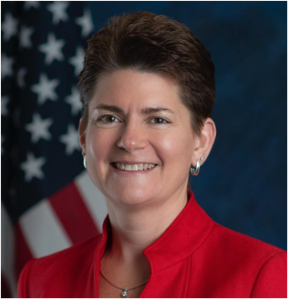Originally published Trump administration’s federal IT policy goals still need more clarity, former officials say on by https://federalnewsnetwork.com/ask-the-cio/2025/08/trump-administrations-federal-it-policy-goals-still-need-more-clarity-former-officials-say/ at Federal News Network
https://federalnewsnetwork.com/wp-content/uploads/2025/06/Trump_67534-1024x732.jpgJust about seven months into the Trump administration and federal chief information officers are waiting for more explicit policy direction.
The Office of Management and Budget has teased a little of their priorities, but lot remains unknown.
At a recent panel of former federal CIOs sponsored by AFFIRM, several weighed in on what they are looking for from Federal CIO Greg Barbaccia.
The panel, which Federal News Network’s executive editor Jason Miller moderated, included:
- David Bray, the chairman of the accelerator at the Loomis Council, a distinguished fellow with the Stimson Center and a former Federal Communications Commission chief information officer.
- Maria Roat, the president of MA Roat Consulting and a former deputy federal CIO.
- Simon Szykman, the president and co-founder of Cambio Digital Transformations and a former Commerce Department CIO
- Sean DuGuay, the chief growth officer for Aretum and a retired criminal investigator and special agent for the Marine Corps.
Here are some excerpts from that June discussion:
Q: What is one federal initiative you’re following closely and why?

DB: I actually am waiting for one that I have not seen, and the one that I have not seen is the federal response to Salt Typhoon and Vault Typhoon. At least nine telecommunications internet service providers were compromised by a threat actor believed to be China. In fact, China hinted that they had done it to compromise as a response to Taiwan and including getting into the FBI. So this administration has inherited it. I am curious that we have not seen a response, especially because there’s also reporting that at least the President’s and the Vice President’s phones during their campaign were compromised by said threat actor too. I was actually just talking [recently] with someone that said, if we wait too long to get past summer, it’s no longer something you inherited from the other administration, it is now on your watch. I was expecting there to be a big push to try and get at least the defense industrial base and to harden things up. I think banking sector would also make sense. We also now have reporting that there are power inverters, that seem to be phoning home just a year ago. So I am waiting for that, because that would have been one of the first things I would have done.
SS: I’m also waiting, rather than tracking, something that’s already out there, but I’m anxiously waiting to read the AI action plan when it comes out. [The Trump administration released the AI action plan in July] That was one of the one of the big priorities, that was, I think, messaged even before President [Donald] Trump entered in office. One of his very first acts was to essentially eliminate a whole host of executive orders from the prior administration, including the AI executive order. We know that AI is important, but we don’t really have a lot of policy behind it. So I’ll be interested to see what comes out there from an operational perspective, and also, for those folks who are tracking what’s happening in the research and development world, or even just reading the news, you’ll know that there are massive budget cuts, sometimes as high as or even higher than 50% in the research agencies, and there are probably maybe three or so priorities that are the only ones not subject to budget cuts, and one of them is AI.
Another one is quantum information science. Clearly this is a priority, but we don’t have a lot of real policy or direction yet, so I’m, I’m interested to see what happens.

MR: I’ve been through a lot of administration changes and generally, by this time, you see shaking out is the form of a plan. Those overarching directionally, hey, here’s what we’re going to focus on for the next three or four years. There’s been a lot of hit or miss, I’ll just call it, [and there are] gaps in policy. You’re seeing things shaking out around acquisition, around GSA, but that bigger picture coming from the Federal CIO, like these are the three things we’re going to talk about [is missing]. If you go back, [to the first Trump administration’s federal CIO] Suzette Kent was very focused IT modernization and doubling down on that. You go to [Obama administration federal CIO] Tony Scott before that and even before that, cloud and priorities and all of those things that was very clear in the early months, even when the federal CIO wasn’t in place in the first couple of months. But you saw what the strategy was. You saw what the priorities were. We’re not seeing that. We don’t know what this is going to look like. We saw an executive order, but sometimes those are about as clear as mud. I think this gets back to, what are those priorities and what’s the plan? I don’t have a crystal ball. I don’t know what the plan is. I don’t know what the Federal CIO is saying, or other than the 16 principles of being a good CIO. But with all the transition, with all the turnover in the CIOs, with all the change, this is a problem. How do you set your priorities? How do you do that? Because as a federal CIO, your priorities around IT and cybersecurity also has to take into account acquisition and contracts when, in fact, there’s been a huge amount of turnover, and you’re not going to be able to execute even if you have those notional things in place that says, here’s what our priorities are.
Q: We know that the Federal CIO has put out some emails that became maybe the initial policies. We know there’s website consolidation, very similar under the IDEA Act. We know that another focus is on software licenses and GSA has been leading that effort. So at least there’s two steps in that direction. Now that we have also an OMB deputy director for management in place, do you get a sense that that’s when we’ll start seeing some of these more specific policy objectives?
MR: I’m going to say I would hope. But hope is not a plan. I would hope that as the President’s Management Agenda (PMA) starts shaking out, because that needs to be done, the agencies are required by law to do strategic plans and all of those kind of things. So I would hope that as the PMA starts shaking out, there’s going to be at least, for the next 18 months, some priorities. Because we all know that in about 18 months, then there’s going to be another election. So this administration, I think, has about 18 months to do something, and it’s going to be until the fall when the PMA comes out, which brings us to 12 months, if there is a PMA at all.
SD: From an industry perspective, I look at it completely differently. I need to run a business. I need to drive revenue. I need to make sure that we’re focused on the right things. So in light of the fact that policies and budgets are not yet finalized, what we focus on is mission efficiency, and that’s all I’ve ever focused on. Every single agency, every rep that I’ve hired over the last 90 to 160 days has been a mission focused rep, somebody who knows what’s going on inside the client. So that’s the first thing, mission efficiency. The reason why I’m bringing that up specifically is I’m going to give you [a few] very quick examples of why this is so important. The Department of State shifted their focus and their mission statement completely changed in February. Their mission statement now is advancing the interests of American people through diplomacy, advocacy and assistance.
The Department of Interior focused on natural resources and heritage, while supplying energy to power in the nation’s future. The Department of Health and Human Services completely change things for the [Make America Healthy Again]. Again, politics aside, I’ve served under multiple presidents, multiple administrations, so to me, this is just a change, and if it changes again — it’s going to change again — you just go with it.
If my team isn’t focused completely on mission enablement and mission success, we’re going to fail as a company, so that’s where I’m focused.
Copyright
© 2025 Federal News Network. All rights reserved. This website is not intended for users located within the European Economic Area.
Originally published Trump administration’s federal IT policy goals still need more clarity, former officials say on by https://federalnewsnetwork.com/ask-the-cio/2025/08/trump-administrations-federal-it-policy-goals-still-need-more-clarity-former-officials-say/ at Federal News Network
Originally published Federal News Network

